By: Jerame Baker; Utah Muskie Hunters
In this article I will go over a brief history of the Tiger Muskie. I will explain the habits and methods used to catch the fish of ten thousand casts. You will learn about the proper gear, proper handling, and where to locate them, and finally what baits to use to catch these elusive apex predators.
The Tiger Muskie is a popular and coveted trophy fish for Utah anglers. They are argumentatively the most challenging fish to catch in Utah. The Muskie has gained a reputation over the years that have earned them a nickname “the fish of ten thousand casts.’ I can’t guarantee that you will catch a Tiger Muskie on your first outing, but it is my hope that the information in this article will give you the knowledge you need to head you in the right direction.
About the Tiger Muskie
Tiger Muskie (Tiger muskellunge) is a sterile hybrid cross between a Muskie (muskellunge) and a Northern Pike. They are a sterile fish and while the cross can occur in the wild, Tiger Muskies are usually raised at DWR hatcheries. Biologists take the eggs from a female pike and the sperm from a male Muskie to create a hybrid Tiger Muskie. The Tiger Muskie can grow up to 50 plus inches and can weigh over 30 pounds. Their most identifiable feature is their vertical stripes that give them their name “Tiger Muskie”. The current Utah State Record Tiger Muskie is 53.0″ and was caught out of Pineview Reservoir.
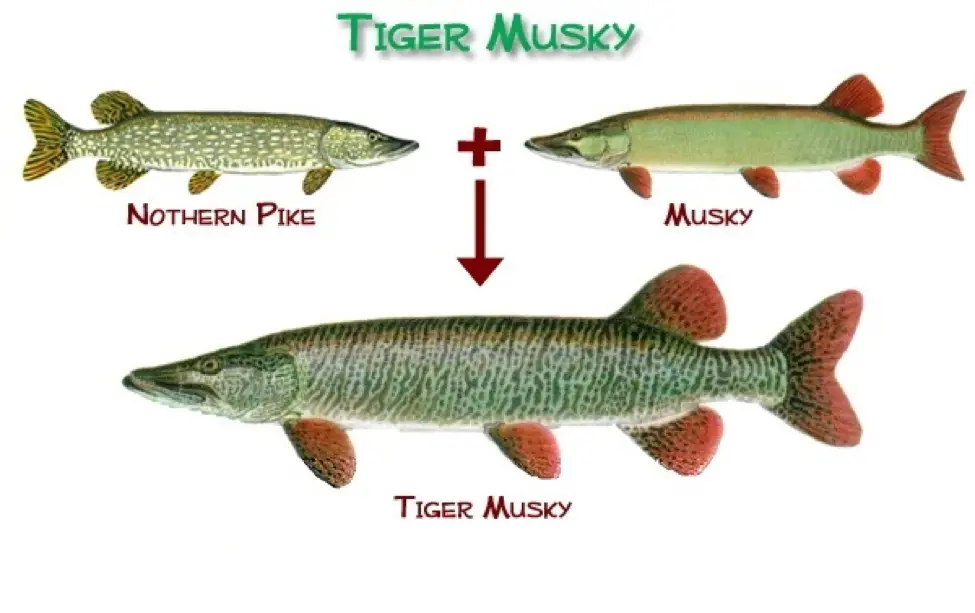
The Tiger Muskie is a relatively new species to Utah, so most anglers in Utah don’t know much about them. The reason they grow at a much more rapid pace is because they do not reproduce and therefore don’t expend energy breeding. The Tiger Muskies main diet consists of fish, frogs, mice and waterfowl. They are cold blooded, meaning their body temperature will reflect the water temperature. These strong fish have become a popular lake management choice for many lakes in Utah. They provide a great trophy fish for anglers and can also help manage other invasive species.
Utah’s Muskie Program
Utah began its Tiger Muskie program back in the 80’s, but in recent years sourced their Muskie from Nebraska from 2009-2017. Rather than pay the expensive costs to source these fish from out of state, Utah built a facility specifically for the production of Tiger Muskie. Utah now has the capabilities to produce their own Tiger Muskie at the Lee Kay Fish Hatchery in Salt Lake City. The Division of Wildlife Resources acquired brood stock Muskie from the Great Lakes Region, and captured Pike from Yuba Reservoir to supplement their program.
The main objective for Utah incorporating the Tiger Muskie stocking program is to combat invasive species in our lakes and reservoirs. Some of these include the chub, carp and other species illegally introduced into Utah’s waterways. Another way Tiger Muskie assists wildlife biologists is by reducing the numbers of pan fish that reproduce rapidly, such as perch, blue gill and crappie.
By adding a sterile predatory fish to the program, biologists can better manage fish populations. The Muskie will reduce invasive species that compete for the same forage as other game fish, thus keeping the aquatic makeup of the reservoir in check. This change will insure that the habitat is healthy and suitable for all fish to thrive in their environment. This management plan avoids the issues of having to poison off a lake and start over when fish populations get out of control.
Where can you find Tiger Muskie in Utah
The best and most popular location to catch Tiger Muskie in Utah is Pineview Reservoir and Joes Valley Reservoir. Both of these locations are blue ribbon fisheries and offer trophy sized Muskie. However, It won’t be long before some of these other reservoirs like Jordanelle and Scofield, once established will start producing trophy sized Muskies. With more reservoirs being added to the stocking program anglers will have multiple opportunities to catch these magnificent fish.
Here are some locations where you can target tiger muskie:
- Pineview Reservoir
- Bullock Reservoir
- Cottonwood Reservoir
- Joes Valley Reservoir
- Newton Reservoir
- Fish Lake
- Jordanelle Reservoir
- Scofield Reservoir
- Yuba Reservoir (Recently added)
Proper Equipment
Having the proper set-up is vital to a successful Tiger Muskie trip. Full disclosure – Muskie fishing isn’t cheap, but take it from experience, you will want to have the right gear. The right equipment is critical to landing these big fish as well as keeping you and the fish safe.
Rods
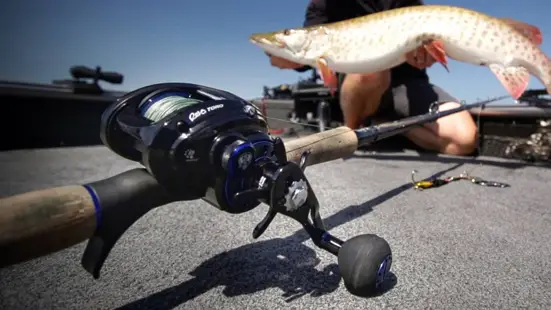
You don’t bring a trout rod to a Muskie Fight! To avoid being out-gunned by this fresh water villain; who by the way won’t hesitate to snap your rod in half. Be sure to come properly equipped with a rod that will level the playing field! Growing up in Utah as a trout fisherman and being new to Muskie fishing; I learned my lesson the hard way after losing not only my fishing rod but the opportunity to land a monster fish. I know it takes time to acquire an impressive fishing arsenal, but make sure you enter the field with the basic weaponry to battle a Muskie. It is better to be prepared then to have to explain to the wife why you need a new fishing rod.
This type of fishing will require you to throw large baits all day (remember fish of ten thousand casts). A bigger rod will allow you to make longer casts and make it a bit easier to handle those bigger Muskie baits. Most avid Muskie anglers fish heavy action rods anywhere from 8-9 feet in length. There is not an ideal rod for all types of applications. Just like bass fisherman have several rods for several situations, so does the avid Muskie angler. The beginner angler will want to choose a rod that has a medium/heavy to a heavy action this will allow you to work top water and glide baits, as well as throw heavy rubber and larger crank baits. I recommend fishing an 8ft or 9ft heavy action rod.
Reels
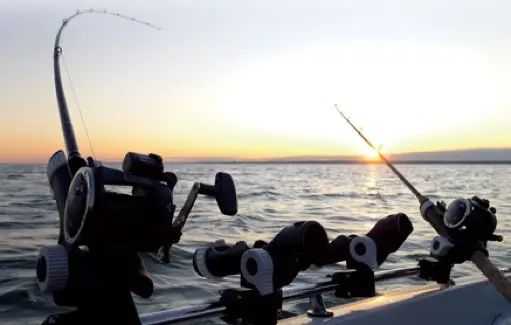
Pairing the right reel with your heavy action rod will insure that you can handle throwing heavy baits as well as fighting big fish. All avid Muskie anglers will tell you to select a large capacity bait caster. Spinning reels are not ideal when targeting Muskie. Fighting a giant Muskie with your reel maxed out is really hard on the bail of a spinning reel. I personally have stripped out two spinning reels before making the switch to a bait caster. A bait caster is a better set up to handle hard fighting big fish.
Your reel’s gear ratio will be dependent on what technique you frequently use; generally you will want a bait caster with a slower gear ratio. Most anglers use gear ratios in the 5.1:1 to 5.7:1 range. It’s also important to get the right size reel; it is recommended to use a large capacity reel to handle heavy line.
Braided Line and Leader

When fighting big time fish with a mouth loaded with sharp teeth, it is a must to use a heavy braided line, as well as a steel leader or a heavy fluorocarbon leader. Not only does a leader act as a bite guard, but it will also protect you from losing expensive baits. I don’t know about you, but I have a hard enough time losing a $5 kastmaster! Muskie baits are expensive so you will want to protect your investment. Most anglers targeting Tiger Muskie use at least 80 lb braided line with a 100 lb fluorocarbon leader. Another good option is a good quality steel leader from a musky shop such as the Anglers Den in Roy, Utah. Every angler has their own preference when it comes to line. I recommend using Power Pro or Tuf-Line, and depending on your set up at least a 50# braid.
Release Tools

Depending on what reservoir you fish there is a mandatory immediate release order for all Tiger Muskies. The most important piece of equipment you will carry will be your release tools. Although the Tiger Muskie is a fierce hard hitting and hard fighting fish, if not handled properly it will die. The Tiger Muskie like its counter parts are a fragile fish that require proper handling to insure a quick and safe release. Having the proper tools is a must and learning how to properly handle a Muskie is equally important. Here is a list of items you will need to quickly and safely care for a Tiger Muskie.
- High leverage hook cutters
- Long Needle-nose pliers
- Jaw spreader (Musky size)
- Muskie Bumper/Tape
- Large Muskie Net
Muskie Net

I know a Large Muskie Net is mentioned above with release tools but I thought I would tell you why a net is so important. Whether you are fishing from a boat or targeting muskies from the shore you will want a large capacity net close by when you hook into your trophy fish. The net not only will help you secure your catch, but it will also serve as a recovery tank while you are gathering your release tools and getting your camera ready. Having a large capacity net will allow your fish to stay calm and recover from the hard fight. It will also allow you to safely remove the hooks with your release tools.
Once the hooks are removed you can pick the muskie up for a quick photo and release it safely and unharmed. If you are fishing from the shore avoid dragging the muskie onto shore. The sand and mud wipes off their protective slime that keeps them from becoming sick or diseased. It is best if you stand in the water with your fish until it is safely released. This is especially important in the summer time when water temps approach 80 degrees. The warm water temps cause a decrease in oxygen in the water and it is much harder for the muskie to breathe and to recover in the heat. Being aware of these issues will help you to be a better muskie angler and insure the health of the tiger muskie.
Recommended Tiger Muskie Nets
Proper Handling
It might seem a little odd to talk about how to properly handle a Tiger Muskie, before I explain what baits to use to catch one. However, every angler is required to know the laws and regulations before entering the field. As sportsman we should also have a rule of ethics that we follow. These unwritten rules are just as important as the written laws in the fishing guide book. Ethics is how we show respect for the fish and for the habitat they live in. Before you venture out on your quest to catch the fish of ten thousand casts, educate yourself on the proper handling techniques so you can insure the fish is returned safely and unharmed. A true sportsman will do everything he/she can to insure the safety of the fish. This is especially important in reservoirs where there is a mandatory immediate release order that requires you to return all Tiger Muskie.
A lot of factors play into handling a large fish. Anyone targeting Muskies should be prepared, well before making the first cast. This means having all your release tools in an area that is easy to get to for quick hook removal. Occasionally a hooked Muskie will get tangled up in the net, and can cause undue stress on the fish. So having the essential tools close by is essential to the Muskies overall health. Once you get the hooks removed, don’t be too quick to pick up the fish for a photo. That Muskie just exerted a tremendous amount of energy in a ferocious fight, and is still trying to catch its breath. The extreme stress of being hooked and landed can build up enough lactic acid to kill a fish, so take a deep breath and calm your emotions for a brief moment and allow the Muskie to recover. There is no doubt that landing such a large fish is one of the most exhilarating moments in any angler’s lifetime, whether Muskies were the target or if the fish was an accidental catch. But there’s no more important time for anglers to calm down than once the fish is netted, making sure it’s safe from harm well before the high-fives begin.
Another sign or indicator that a Tiger Muskie is stressed is the color of its fins. If the fins and tail are tinted bright-red, it signifies a high level of stress. One of the reasons we suggested earlier to use a heavy braided line was to avoid having to fight a Muskie for a long period of time. Like mentioned above a Tiger Muskie exerts a tremendous amount of energy after being hooked. It is important to the health of the Tiger Muskie to get the fish in quick, thus minimizing the risk of the Muskie becoming overly stressed. That being said let’s talk about the two best ways to hold a Tiger Muskie.
Gill Plate Hold

The first and most important item to remember is that there is a big difference between Gills and Gill Plates. You should never grab a fish by the Gills.
The main goal of a “Gill Plate Hold” is to control the head of the fish from violent thrashing. By following these steps below, you can avoid a mistake that could result in your bleeding or the fish’s mortality rate increasing.
1. Start by curling your fingers into the shape of U (just four fingers, not your thumb). Pretend as you are grabbing a pull up bar, your hand will be in a similar formation.
2. Once your hand is in formation, slip your hand under the fish’s gill plates. It doesn’t matter if you are grabbing the left gill plate or the right gill plate. You can decide what gill plate to grab based on the position of the fish and your body.
3. Your fingers (still in the U shape) will be touching the inside surface of the plate covering the gills. Again, do not grab the gills!
4. When your fingers are touching the inside surface of the gill plate, you will position your right thumb forward, essentially parallel to the head of the fish.
5. Squeeze your fingers (still in the U shape) toward your thumb. This will provide you a nice grip on the fish.
6. You can now move into position for a photo or a release. Holding the fish horizontal is recommended for the best photo opportunity.
Horizontal Hold
This hold is a simple one but does not offer as much control as the gill plate hold. If you choose this hold make sure you are in a position where you can release the fish if you do happen to lose control.
1. While the Muskie is still in the net, reach down and take a firm grip just above its tail.
2. Once you have a firm grip of the tail, slide your other hand along its belly just below the front fins.
3. After you have a good hold of the Muskie you can move into a position for a photo.
Below you can see an example of a Horizontal Hold. It is a small variation from the Gill Plate hold but both are safe and effective ways to hold a Muskie.
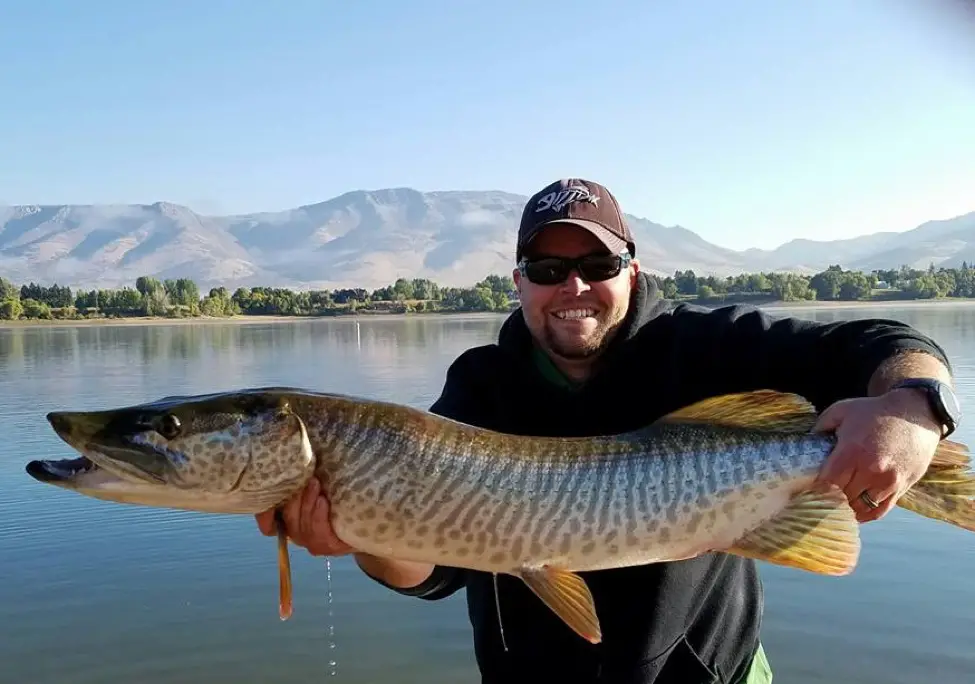
Methods used to catch a Muskie
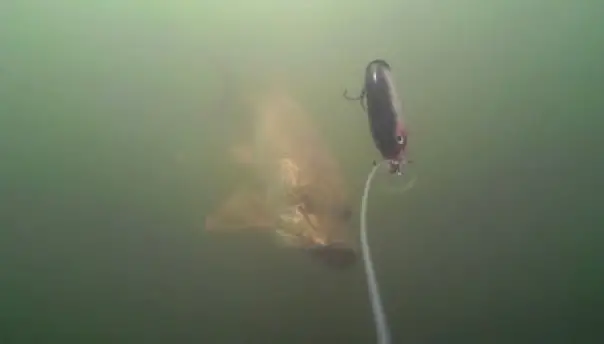
So I know everyone wants to know what the secret is to catching a Muskie. If you are planning the camp chair and power bait approach, with your favorite beverage in your hand, you’re probably not going to be very successful. That being said let’s talk briefly about how a Muskie thinks. Like I mentioned earlier a Tiger Muskies main source of food is… you guessed it fish! If you are expecting to catch a Tiger Muskie you will first need to locate the bait fish. Like the old saying goes; “if you want to find the fish, follow the forage”, or as fly fisherman would say “match the hatch”. Muskies often times are ambush predators, and will lay and wait motionless for their prey. With eyes that are located on the top of their head, the Tiger Muskie looks for his prey most frequently above him. So if you stand in one place and cast like you do for trout you will have a hard time locating where they are located.
Match the Forage
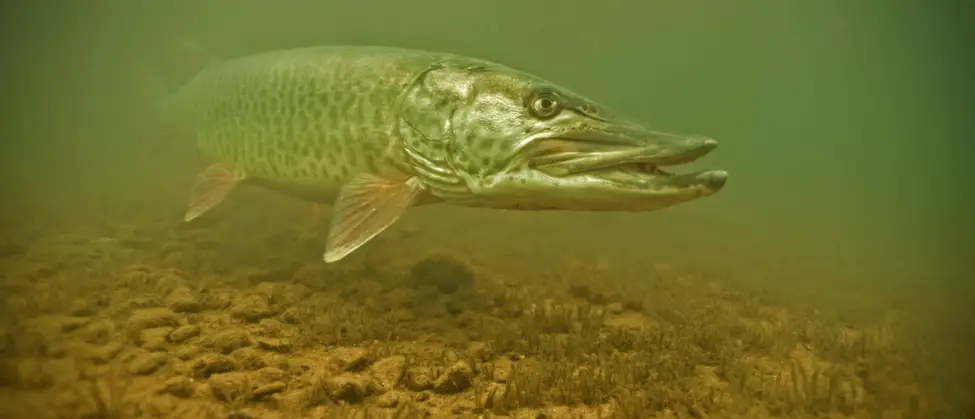
To locate Muskies be prepared to move frequently and segment the lake with each cast. While you are moving from one location to another search out areas that hold smaller bait fish. These areas will most likely be around weed beds, structure and transitional areas like shelves where the lake has a drastic change in depth. It is also a good rule of thumb to match the colors of baits to the forage in the lake. So if you are fishing Pineview Reservoir I recommend using lures that resemble a perch, black crappie or a small mouth bass.
Muskie Baits
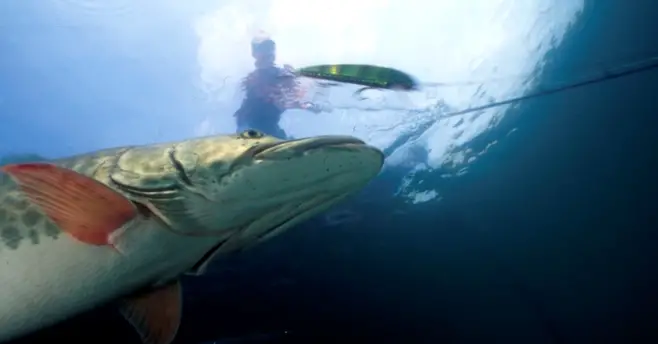
Picking the right bait for the right scenario your fishing is key to finding that lure that will allow you to punch that ticket and land a trophy. Tiger Muskie fishing takes a lot of guess work. So in order to take some of that guess work away we are going to break it down into categories. Just like bass fishing there are certain baits for different applications.
If you are new to tiger muskie fishing be sure to check out our other article “The Best Tiger Muskie Lures For Beginners” for some great baits to start with.
Top Water- Early morning before the sun comes up when the lake is glass and perfectly calm is a great time to throw top water. This same thing applies in the evenings when you are watching the sun go down wishing Mother Nature would give you five more minutes of fishing time. There are several types of top water baits to choose from, walk the dog, ploppers and crawlers. This style of fishing is the most exciting when you have unexpected blow ups on the surface, or can see a wake of an incoming Muskie headed straight for your lure. There is nothing like watching the explosion on the surface followed by the setting of the hook.
Suggested Lures
Crank baits- When you are fishing from a boat or in deeper water and you are looking for a lure that will dive and make a lot of chatter this is the bait to use. Muskies love noisy baits and crank baits with rattles are big producers. There are different crank baits for different depths so if you are fishing from shore you will want to choose a shallow diver that won’t get snagged up in the foliage and on the bottom of the lake.
Suggested Lures
Spinner baits- One of the most classic Muskie baits is a buck tail. These over sized spinner baits are a proven method for catching trophy Muskies. Buck tails come in different size blades and can be used in multiple situations. Spinner baits also come in a one blade or a two blade option that give a different vibration in the water. Spinner baits are a great option when throwing into weed beds and areas of vegetation. The large blades keep the hooks from getting caught up in the grass and weeds and allow you to fish areas that are more difficult when fishing other baits.
Suggested Lures
Swim baits- Probably the best bait when it comes to mimicking the forage. Jointed swim baits have great action and can be a great option when trying to fool a crafty and elusive Muskie. Swim baits generally do not have a lip and don’t dive like crank baits. This bait can easily be manipulated to resemble a wounded fish. An occasional pause or light snap of the rod can often times trigger a response from a Tiger Muskie.
Rubber baits- Muskies have shown that they love big rubber baits. I don’t know what it is about these eel shaped baits, but the Muskie seems to love them. These baits can be fished fast or slow and offer a lot of action with their long tails. The most common rubber bait is called a bull dawg; this bait is used mainly in the summer time when the Muskie is looking for larger prey.
Suggest Baits
Jerk baits- The side to side action of jerk baits are a favorite amongst most Muskie anglers. This bait can be a little more challenging to master, but once you learn to fish jerk baits it can be a rewarding bait to fish. You can fish these baits aggressively or finesse style and can have a lot of success. Jerk baits seem to know how to get the attention of a Tiger Muskie. These baits can be fished slower in the spring time or fast in the summer.
Change Things Up
The tiger muskie is a very curious fish and will frequently follow bait to the boat or shoreline. In order to trigger a response it is best if you mix up your retrieve. Try different speeds and different techniques. Don’t be afraid to give your lure an occasional jerk or twitch. This change in direction or action of your lure often times will trigger a response and will result in a hook up. If you are on a boat and observe a muskie hot on your tail, speed up your lure and go into a figure eight motion with your pole tip in the water. This fast change in direction and motion often times will result in a boat side attack that will get your adrenaline pumping and a memory will never forget.
Emotions
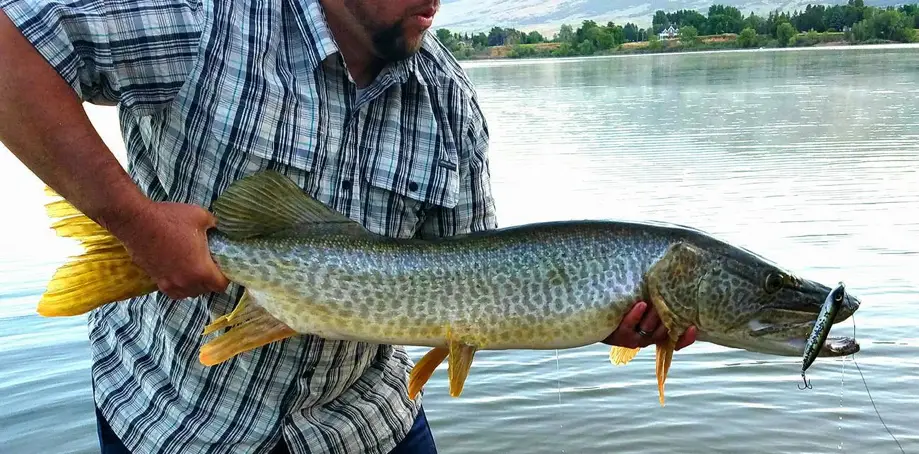
Believe me there is nothing more exciting then hooking up with a Tiger Muskie. The rush and feeling of sheer power of a ferocious apex predator is one of those “you had to be there and experience it for yourself” types of experiences. There are a lot of emotions involved with Muskie fishing. Those who have experienced catching a Tiger Muskie know how quick it becomes an addiction and a fish you want to experience again.
But don’t be surprised if you experience the down side of Muskie fishing. I have had days where I have walked miles of shoreline with a sore arm and an aching back with the sun beating down on me wondering if I should set my pole down or continue to power through it. On a few of these trips I left empty handed after beating the shorelines for 8-10 hours. Sometimes that is what sets apart a muskie fisherman from the average Joe. You have to have the attitude that you are there to catch a muskie. If you have predetermined thoughts of I will try for muskie and it doesn’t work out I’ll switch to small mouth bass, well guess what; you will end up catching small mouth bass.
Dedication and Perseverance
The Tiger Muskie is a very picky eater and often times will test your patience and your endurance and quite frankly your sanity too. There are times where I have become so frustrated with chasing these uncooperative fish that I threaten to sell off all my gear and go back to catching trout on power bait. Well that never happens, and by the time I get home I am already planning my next trip for yet another round of beating shorelines. I guess what I am trying to say is don’t stay down on the mat for very long, get up and keep swinging because you never know when you are going to land that knockout punch.
Muskies often times will eat during certain feeding windows that are not easy to figure out especially if you don’t spend much time chasing them. Avid Muskie fisherman also study moon phases to determine best feeding times. The best way to catch a Muskie is by spending time on the water being in the right spot at the right time. I am not saying that catching a Muskie is pure luck.
But what I am saying is you can tip the scales in your favor by having a no quit attitude and being relentless in your pursuit. Putting in the work will pay off dividends when you finally do hook up with a giant Muskie. The Muskie will decide what is on the menu for that day, so that is where the challenge begins. It is your task to figure out what it is the Muskie wants. To help you with that challenging task I will do my best to help you out. If you are lucky that will happen on cast number 5, but don’t be surprised if it takes all 10,000 casts before it happens.
Fishing Seasons
Spring
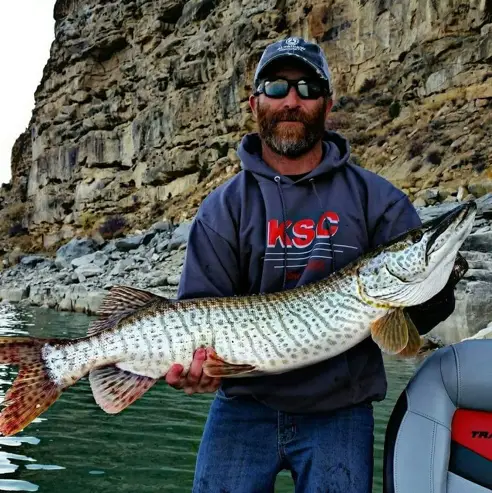
Spring time can be one of the best times of the year to target Tiger Muskie in Utah. Water temperatures are extremely important to keep in mind in the spring. Typically, Muskie are most active when water temperatures reach 56 degrees. This is when smaller fish like the perch start breeding and the Muskie move in closer to the shoreline. The golden rule of Tiger Muskie fishing is: “find the bait, find the Muskies”. With winter in the rear view mirror and with the cooler temperatures in the spring, you will want to fish slow and use more finesse tactics. During the spring they prefer to prey on smaller easier targets due to their slow metabolism. Try using swim baits that will mimic your lakes forage. Lures such as crank baits, spoons, and jerk baits are all great options. Fly fishing can also be a great technique.
The time of day is also important in the springtime. The best time to go fishing is whenever you have time. However, you may find more success in the spring on warmer days and later in the day. During this time of year tiger musky can be found at or around spawning flats, transitional areas and rocky shorelines.
Locations:
- Weeds
- Points
- Sand/Rocks
- Depth Breaks
Summer

Summer brings great opportunities and a few challenges. Water temperatures have moved from spawning temperatures to higher water temperatures, and as the temperatures rises, so will the activity of the Muskie. This time of year Muskie are actively feeding. They need to be able to keep up with their higher metabolic rate as water temperatures rise. The summer months are the time for you to up your bait size and retrieving speed. The muskie will be targeting bigger meals to keep up with their caloric demand.
Summer also gives you longer day which can mean more fishing hours, but it also can present some challenges. Lakes in Utah get super busy in the summer, especially if you are fishing Pineview Reservoir. It’s best to shy away from the recreational boat traffic and stick to early mornings and evenings. Try and target cooler times of the day, especially in the late summer. It will make it easier on the fish as well, so make sure you plan your fishing trips accordingly. The other thing to watch out for in the summer is the water levels. Depending on the year you might be faced with high water levels early summer, but near the end of summer you are guaranteed to be faced dropping water levels.
Locations
- Weeds (Depending on water level)
- Main Lake Points
- Transition Areas
- Depth Breaks
Fall

Fall fishing in Utah is typically in September, or when the water temperature reaches about 60 degrees. Fishing in the fall presents some challenges with lower water levels, colder temperatures, and water turnover. But typically the biggest Tiger Muskie can be caught in the fall
This time of year can really be hit or miss. The fish are still actively feeding trying to fat up for the winter time, but can also be easily turned off with a cold front. Try fishing your spots quicker to really understand what the fish are doing. Things can change so fast so it’s important to always adapt and try new things, especially in the fall.

